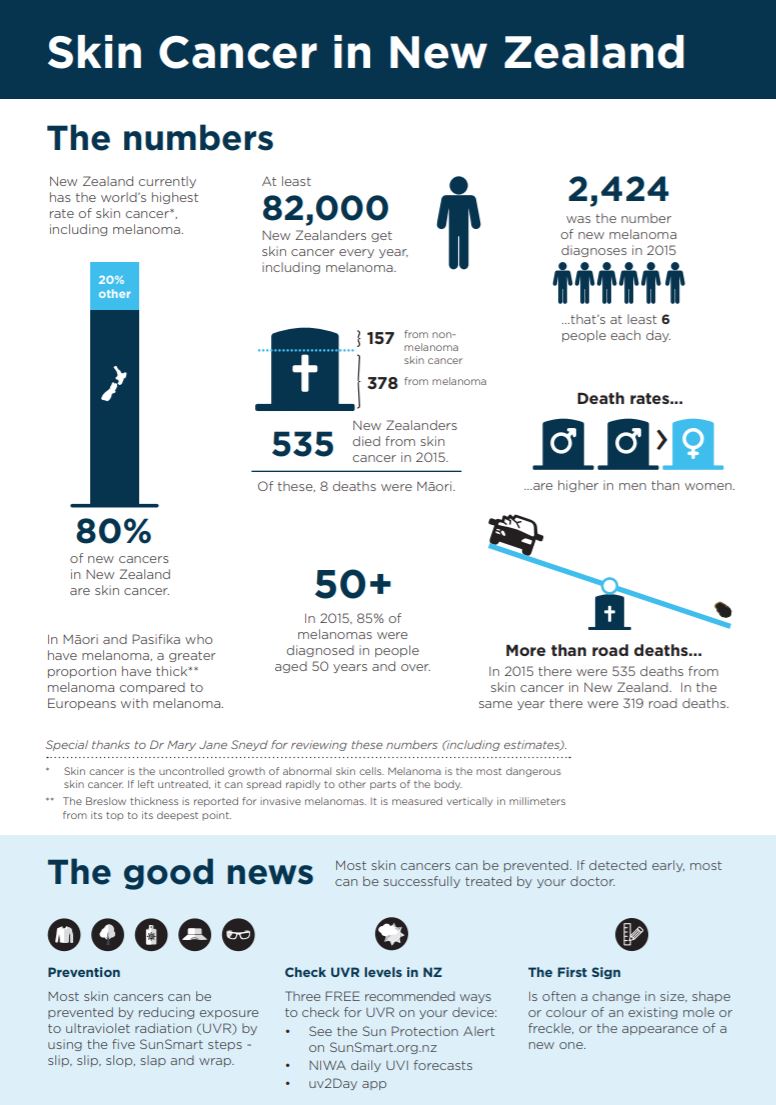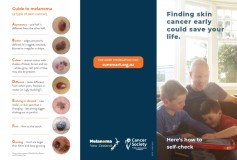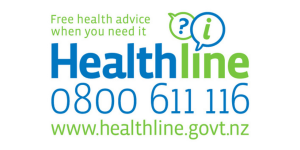Wishing everyone happy holidays and a joyful New Year from the Healthify team. Don't forget to Slip, Slop, Slap and Wrap!
Skin cancer
Key points about skin cancer
- Skin cancer occurs when skin cells become damaged and grow in an uncontrollable way.
- It’s the most common cancer affecting New Zealanders, with melanoma being the most serious type. However, it’s largely preventable.
- If you protect your skin from sun damage throughout your life, you’ll greatly reduce your risk of skin cancer.
- When found early, most skin cancers can be successfully treated.
- Check your skin regularly so you can pick up any changes.

Skin cancer happens when skin cells are damaged and grow in an uncontrollable way. It’s the most common cancer affecting New Zealanders, however, it’s largely preventable.
If you protect your skin from sun damage throughout your life, you’ll greatly reduce your risk of skin cancer.
There 2 groups of skin cancers – melanoma and non-melanoma. Melanoma is the most serious type of skin cancer and is the cause of more than 2 out of 3 deaths from skin cancer.
You should check your skin regularly so you can pick up any changes, such as new spots or moles that look different from when you last checked them.
Melanoma can arise from moles or from skin without any pre-existing mole being present.
When found early, most skin cancers can be successfully treated.
Video: What is skin cancer?
This video is from the Irish Cancer Society so contains contact details that don't apply to Aotearoa New Zealand.
(Irish Cancer Society, 2024)
Most skin cancer is caused by ultraviolet (UV) light damaging your skin’s cells. The main source of UV light is the sun. Artificial sources of UV light, such as sunlamps or tanning beds, can also increase your risk of skin cancer.
Protecting your skin from the sun (and not using sunbeds) combined with regular skin checks, is the best way to prevent skin cancer or find skin cancer early. Read more about how to do a skin cancer check and how to reduce your risk of skin cancer.
Types of skin cancer
There are 2 groups of skin cancers – melanoma and non-melanoma.
Melanoma is a type of cancer that develops in your skin’s pigment cells (melanocytes). These are the cells that give your skin its colouring. Melanoma is less common but is often more serious than non-melanoma skin cancer.
Non-melanoma skin cancer refers to a group of cancers that usually develop slowly in the upper layers of your skin. The 2 most common types of non-melanoma skin cancer are basal cell carcinoma (BCC) and squamous cell carcinoma (SCC). Sometimes squamous cell carcinoma can develop very quickly, especially if you're an older adult or have a compromised (weak) immune system.
Melanoma:
- usually appears as a changed or new freckle or mole
- often has an unusual shape or colour, or a variety of colours, but sometimes may not be coloured
- may itch, bleed or weep
- may become raised quickly and catch on clothing
- if not treated untreated, melanoma can spread rapidly to other parts of your body and become life-threatening.
Read more about melanoma.
Basal cell carcinoma (BCC):
- is the most common and the least serious form of skin cancer (as long as it’s treated) – left untreated they eat into what ever tissue (skin, nerves, fat, muscle) is next to them
- appears as a pale, red or pearly, smooth lump, usually on your face or neck – the surface may be very weak and bleed with rubbing
- is more common among older people, but can develop in people in their early 40s or even younger.
Read more about basal cell carcinoma.
Squamous cell carcinoma (SCC)
- is common in people over the age of 40 years who have spent a lot of time outdoors
- often appears as a raised, crusty, non-healing sore – often found on your hands, forearms, ears, face or neck
- is easily treated if found early but can be life-threatening if not treated.
Read more about squamous cell carcinoma.
Are solar keratoses a type of skin cancer?
Solar keratoses or sunspots are not a type of skin cancer. However, they are a sign of sun damage to your skin and a warning that you may be prone to skin cancer. Solar keratoses are flat, red or sometimes brown, scaly areas, which may sting if scratched. They are very common in fair-skinned people over 40 years of age who have spent a lot of time outdoors.
People of all ages and skin colours can be diagnosed with skin cancer but you're at higher risk if you have:
- fair, light-coloured skin
- blue or green eyes
- blonde or red hair
- skin that burns easily
- had severe sunburn on one or more occasions, especially as a child
- spent a lot of time outdoors unprotected from the sun
- used sunbeds, particularly at a young age
- a family history of skin cancer
- a large number of moles or large, irregularly shaped and unevenly coloured moles
- a weakened immune system.
In Aotearoa New Zealand our high skin cancer rates are due to:
- high levels of UV radiation during daylight-saving months
- low ozone levels
- our outdoor lifestyle
- a high proportion of people with fair skin
- relatively cool temperatures, so people often seek the sun rather than the shade.
Most of us have freckles, moles or other spots on our skin. This is normal. However, you should see your doctor or skin specialist if you have a freckle, mole or spot that:
- is new or changing
- doesn't heal
- looks different from others around it
- has changed in size, thickness, shape, colour
- has started to bleed.
Have your skin checked by a healthcare provider immediately if you notice any of the changes described above.
Your GP can also perform a skin check in combination with a general health check-up. If you are at higher risk of skin cancer, you may need regular skin checks as advised by your doctor.
All New Zealanders should become familiar with their skin by doing regular skin self-checks (preferably once every 3 months). Being familiar with your skin means you will be more likely to notice any suspicious lumps or spots as soon as they develop, and at a stage when they can be successfully treated.
It's particularly important to do regular skin checks if:
- you're over 50 years of age
- you have a family history of skin cancer, or
- you've had any bad sunburn as a child.
Checking your skin regularly, including skin that’s not normally exposed to the sun, will help you get to know how your skin normally looks so you can be aware of any changes. This is especially important as you get older, particularly if you’re over 50.
Make sure you check your whole body, as skin cancers can occur on parts of your body that aren’t exposed to the sun.
Take the following steps to check your skin:
- Use a hand-held mirror or ask for help from someone else to check hard-to-see areas, such as your back and neck.
- Check everywhere including underneath your armpits, inner legs, ears, eyelids, hands and feet and between your toes.
- On your head, use a comb to move sections of hair aside and check your whole scalp.
- If you notice any skin changes, see your healthcare provider.
Video: Self examination skin check
Skin check apps (also called melanoma detection apps)
There are a variety of apps that allow you to take photos of your skin and track and monitor changes to your skin lesions. These may be useful for learning more about melanoma and for capturing images of skin lesions such as moles. These apps shouldn’t replace advice from your healthcare provider when you notice changes to your skin or existing moles. They shouldn't be relied upon and may not be as good at detecting non-melanoma skin cancer. If there are concerns, see a dermatologist.
Read more about skin check apps.
If you notice a change to, or a growth on, your skin make an appointment to see your regular healthcare provider straight away. They’ll assess the size, location and look of the growth. They’ll also ask you how long you’ve had it, whether it bleeds or itches, etc. They’ll usually examine the rest of your skin too to check for other abnormal changes. They may use a special magnifying light known as a dermascope to look at any suspicious spots or growths.
If your healthcare provider thinks the growth may be cancer, they may take a small sample of skin tissue (a biopsy). The tissue sample will be sent to a laboratory and examined under a microscope. Your healthcare provider will let you know whether the sample showed any cancer cells, and will recommend appropriate treatment and referral to a skin specialist (dermatologist) if necessary.
Unlike many other cancers, you can often see a skin cancer which makes it easier to catch early on. Most skin cancers can be successfully treated if they’re caught early.
Treatment depends on the type, size, location and number of skin cancers you have, and whether the cancer has spread to other parts of your body.
Treatments for superficial (surface) skin cancers
Surgery
Most skin cancers are treated by surgery (cutting out the cancer). This is done using a local anaesthetic to numb your skin. Types of surgery include excision biopsy and Mohs surgery.
- Excision biopsy: This is where the lesion is completely cut out along with some of the normal surrounding tissue. The tissue is sent to the lab and if it’s confirmed to be skin cancer you may need further surgery to remove more of the surrounding skin.
- Mohs surgery: This is a more intensive type of surgery that can be used to remove large or deep cancers or cancers that come back after they’ve been treated. It can also be used for cancers that are difficult to treat by other surgical methods, such as cancers near your eye. Its especially useful for tumours with indistinct margins (where the edge isn't obvious).
If your skin cancer is small and limited to the surface of your skin, removing it through a skin biopsy may be the only treatment you need.
Cryotherapy
This is the use of extreme cold (eg, liquid nitrogen) to treat pre-cancerous skin conditions such as solar keratoses and some small skin cancers. Liquid nitrogen is applied to the tumour to freeze and kill the abnormal cells. Some pain and redness may occur afterwards, and a blister may develop on the treated area. There may be a white mark or scar from the treatment.
Topical therapy
Topical therapy means applying a cream to the skin cancer. Fluorouracil cream can be applied directly to your skin once or twice a day for several weeks. The area will become red, then there will be blistering, peeling or cracking. The skin settles and heals once the treatment has finished. Fluorouracil cream is used to treat sun-damaged skin, pre-cancerous skin lesions such as actinic keratoses (also called solar keratoses), squamous cell carcinoma in situ and for the treatment of superficial basal cell carcinoma in low risk locations.
Imiquimod cream can be used to treat pre-cancerous lesions and superficial basal cell carcinomas (BCCs). It stimulates your immune system to recognise and destroy cancer cells. You apply it to your skin, usually several times a week, for 4 to 6 weeks.
Photodynamic therapy
This uses a light source (such as a laser or even the sun) and a photosensitising cream. First, the skin with the cancer is lightly scraped and a cream is applied to make the cancer cells sensitive to light. Then a few hours later, the area is exposed to a light source, so the cancer cells can be destroyed. If you feel any pain, you’ll be given a local anaesthetic.
Radiotherapy
Radiotherapy is an option for hard-to-treat skin cancer, such as cancer on your eyelids or nose, or if you’re not medically fit for surgery. It uses high-energy X-rays to destroy cancer cells. Treatments usually occur for a short time daily or weekly. The area may become red and sore, and there may be changes in skin colour and/or texture in the long term. Sometimes radiotherapy is given at the place where a skin cancer's been removed to lower the risk of it returning in that location – especially if the laboratory analysis identified high risk factors.
Treatment for advanced or metastatic skin cancer
Advanced or metastatic skin cancer, where the cancer has spread to other parts of your body, can be harder to treat. Medicines used include targeted therapies that block the action of certain genes and proteins.
If you have advanced melanoma that has spread to other parts of your body (stage 3 or 4), you may need a combination of surgery, medicines and radiation therapy. Medicines used to treat advanced melanoma include targeted therapies and immunotherapy such as pembrolizumab (Keytruda).
Skin cancer is preventable. Over 90% of all skin cancer cases are caused by excess sun exposure. If you protect your skin and avoid sunburn throughout your life, you will greatly reduce your risk of skin cancer. Remember to protect your children's skin too
In Aotearoa New Zealand, be SunSmart(external link) from September to April – avoid outdoor activities between 10am and 4pm when UV radiation levels are very high. Use UV protection every day as UV can still be damaging on cool, cloudy days.
In winter it's also important to be SunSmart at high altitudes and around snow or water.
Avoid getting a tan and never use tanning beds or sun lamps.
People with high risk factors for getting skin cancer may lower the rate by taking high doses of Vitamin B3 (nicotinamide). This should be discussed with your healthcare provider before starting.
Steps to being SunSmart – remember to Slip, Slop, Slap and Wrap:
- Slip into shade where possible.
- Slip on some sun protective clothing, for example, a shirt with a collar and long sleeves, and trousers or long-legged shorts.
- Slop on broad-spectrum sunscreen that has a sun protection factor (SPF) of at least 30. Apply sunscreen to every part of your body that won't be covered. Apply the sunscreen 20 minutes before you go outside, and re-apply every 2 hours, especially if you're swimming or sweating. Use a prtective lip balm too.
- Slap on a hat that protects your face, head, neck and ears.
- Wrap on some close-fitting sunglasses.
The Melnet group of experts has produced an excellent document on skin cancer prevention and early detection(external link).

Image credit: Canva
What if I've had a lot of sun exposure in my life?
Before the dangers of sun exposure were fully understood, many New Zealanders spent a lot of time outdoors without sun protection or used tanning beds. If you're worried you may have increased your risk of skin cancer in this way, the key is to prevent further skin damage and to have regular skin checks with your healthcare provider. If you notice any darker, growing or changing moles, get them checked straight away.
(Conquering Cancer, Australia, 2024)
The Cancer Society(external link) provide a wide range of support and resources to help people and their families living with any form of cancer. There are support groups(external link) throughout Aotearoa New Zealand.
NZ cancer (oncology) services – find a hospital/service near you(external link) Healthpoint, NZ.
The Cancer Society and SunSmart website have lots of useful information including:
Skin cancer
Skin cancer – matepukupuku kiri(external link) Cancer Society, NZ
Check your skin(external link) SunSmart, NZ
Living well with advanced cancer(external link) Cancer Society, NZ
Sun protection (SunSmart)
Be SunSmart(external link)
Slip on clothing(external link)
Slip into shade(external link)
Slop on sunscreen(external link)
Slap on a hat(external link)
Wrap on sunglasses(external link)
Brochures
Finding skin cancer early could save your life – here’s how to self-check(external link) Melanoma New Zealand and Cancer Society, NZ, 2021
Sun safety for deeper skin tones(external link) Cancer Society and SunSmart, NZ
Skin cancer in New Zealand(external link) Cancer Society and SunSmart, NZ, 2021
Position statement – skin cancer screening and early detection(external link) Cancer Society, 2020
References
- Skin cancer(external link) DermNet NZ, 2017
- Non-melanoma skin cancer(external link) Auckland Community HealthPathways, NZ, 2021
- Sunbeds(external link) Health New Zealand | Te Whatu Ora, NZ, 2024
See our page Skin cancer for healthcare providers
Brochures

SunSmart, NZ, 2021

Finding skin cancer early could save your life – here's how to self-check
Melanoma New Zealand & Cancer Society, NZ

Sun safety for deeper skin tones
Cancer Society, NZ
Credits: Healthify editorial team. Healthify is brought to you by Health Navigator Charitable Trust.
Reviewed by: Dr Scott Barker, Consultant Dermatologist, NZ Dermatology and Skin Cancer Centre
Last reviewed:





